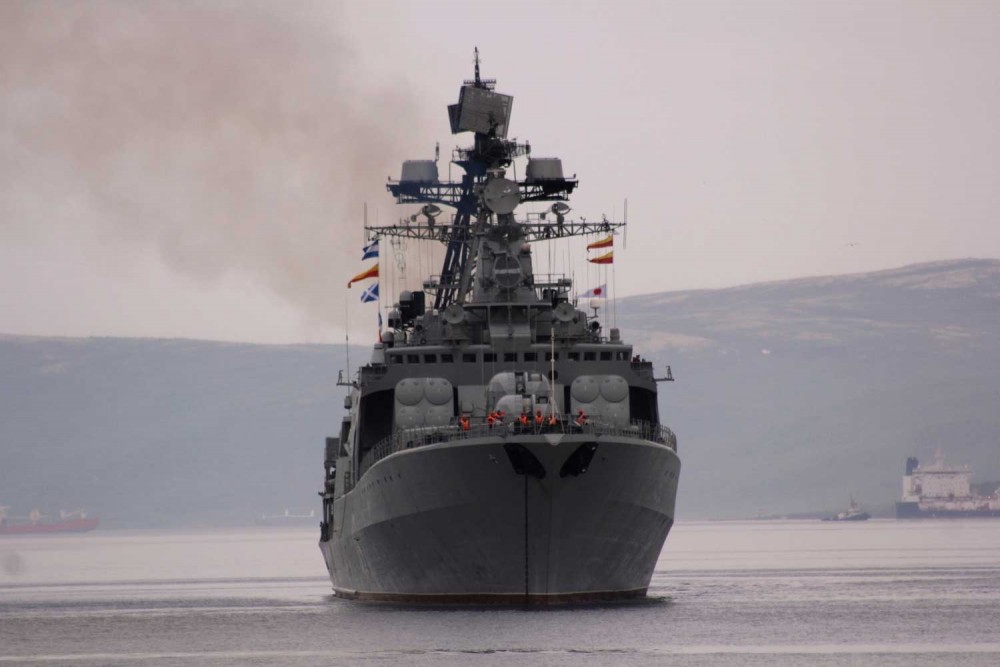Small Norwegian fishing boat confronted Russian warship during live-shooting exercise
Shootings or not, the fishermen wanted to secure their catch and confronted the Northern Fleet’s large destroyer Admiral Levchenko in the maritime border area north of the Varanger Peninsula.
“This is Russian warship, you need to leave the area”, was the message chief mate Øystein Orten got over the radio as his crew was about to take the fishing gear up from the water.
It was news online FriFagbevegelse that first talked with the crew of the fishing boat Ragnhild Kristine about the scary confrontation with the Russian navy in the Barents Sea.
The incident happened on September 12th in the maritime border areas north of the Varanger Peninsula. Outside territorial waters, but in Norwegian Exclusive Economic Zone (EEZ). Here, Russia’s Northern Fleet had pre-annonced live shootings as part of the large-scale strategic exercise Ocean-2024.
But the military exercise and the order to sail away didn’t at first scare the Norwegians.
“I replied that it was out of question for us to move. We had longlines to take onboard,” Orten told to FriFagbevegelse.
The Admiral Levchenko is an anti-submarine destroyer and one of the largest warships in the Northern Fleet.
Warning shot
Øystein Orten and his crew of five onboard the 15-meters small fishing boat saw the huge warship sailing towards them and first stopped at a distance of 200 meters.
The warship then blew the powerful horn for about 15 seconds. According to Orten, the Admiral Levchenko fired a warning shot that exploded in the water. “It was a powerful blast, our boat was shaking,” Øystein Orten tells.
The Norwegians fishermen decided to sail west and the 163-meters long destroyer followed until the fishing boat was out of the danger zone.
“There the Norwegian Coast Guard came and talked [over radio] with the Russian ship.”
Coast Guard can’t confirm
“We had a Coast Guard vessel in the area and we know there was a conversation between the Russian navy and the fishing boat,” says head of communication with the Norwegian Joint Headquarters, lieutenant colonel Vegard Finberg in a phone interview with the Barents Observer.
“There are, however, nothing from our observations that can confirm any warning shot,” says Finberg, but he underlines that “the fishermen might have experienced the situation different.”
Norwegian fishermen have several times over the past few years protested Russia’s extensive navy shootings in the Barents Sea.
“Norwegian authorities must put pressure on Russia so that they stop sabotaging Norwegian fisheries and shipping,” says Øystein Orten in the interview with FriFagbevegelse.
“Ideally, the Russians can place the firing range further north, east and in their own area. They should not be allowed to close Norwegian fishing areas,” Orten says.

More Varanger fjord exercises
A recent study made in collaboration between the Norwegian Defense Research Establishment (FFI), Nord University and the Barents Observer of Russian NOTAMs (Notice to Airmen) in Norwegian EEZ shows that more of the Northern Fleet’s exercises takes place across the maritime border in the Barents Sea.
“Our study showed that there has been an increase in the average size of Russia’s naval exercise areas in the Barents Sea in recent years, and that many of them are laid across the Norwegian-Russian maritime delimitation line, outside the territorial waters of both states,” says Kristian Åtland, senior researcher with FFI.
“They are in other words located partly in Russia’s Exclusive Economic Zone, and partly in Norway’s. Russia’s live-fire training events in the High North also last longer than they used to do in the past,” Åtland explains.
The study is published in the the Scandinavian Journal of Military Studies.

Last fall, Russia announced missile shootings north and south of the Bear Island in Norwegian EEZ of the Barents Sea. The move caused Norwegian officials to fear for the Search- and Rescue capacities in the area in case of emergencies.
In May this year, Russia closed off an area west of the Fishermen Peninsula for artillery firing. At the nearest the no-sail zone was just 4 nautical miles from where Russia’s land border with Norway meets the maritime border into the Barents Sea.
Located in Kirkenes, Norway, just a few kilometres from the borders to Russia and Finland, the Barents Observer is dedicated to cross-border journalism in Scandinavia, Russia and the wider Arctic.
As a non-profit stock company that is fully owned by its reporters, its editorial decisions are free of regional, national or private-sector influence. It has been a partner to ABJ and its predecessors since 2016.
